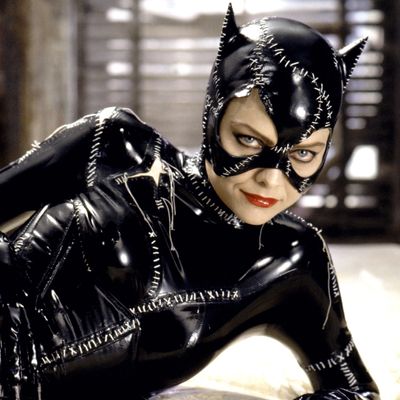
In an age of superhero movies and TV anti-heroes, fictional villains are more complex than ever before. This week, Vulture examines villainous entertainment in all its forms.
There’s a lot to admire about Batman Returns, the 1992 sequel from director Tim Burton that celebrates its 25th anniversary this month. The script by Daniel Waters, who also wrote the sharp, 1988 black comedy Heathers, is equal parts lurid and alluring. Burton and cinematographer Stefan Czapsky heighten the gothic melodrama of Gotham by creating a surreal cityscape where the fantastic lurks around every corner. Composer Danny Elfman’s swooning score frames the film as a dark fable. And there’s an attention to detail and intimacy that the superhero genre has lacked as it’s gained renewed prominence in the 25 years since.
But perhaps the best part of the movie is Michelle Pfeiffer. The last quarter century has also seen countless comic villains come to life onscreen — Tom Hiddleston’s vengeful trickster Loki and Heath Ledger’s madcap manic Joker being notable examples — but Pfeiffer’s Catwoman still towers over them all. She remains the most incisive depiction of villainy the genre has ever seen cinematically.
Batman Returns follows the titular Caped Crusader, Bruce Wayne (Michael Keaton), as he protects his beloved city from ruthless industrialist Max Shreck (Christopher Walken), and the deformed crime boss known as the Penguin (Danny DeVito). Among all the latex, leather, and snowcapped buildings, Pfeiffer enchants as Selina Kyle, the secretary pushed to her death by Shreck, who miraculously survives and goes on to become the vengeful Catwoman. Moments after she falls, Selina is overrun by a horde of cats. Her body twitches as if her soul is trying to reconfigure itself. A cat gnaws at her bloody hand. Her eyes pop open as if a wire has been tripped, bringing her back to the land of the living. What follows is one of the most transfixing sequences of a supervillain’s awakening ever filmed. It’s hard to believe Pfeiffer wasn’t the first choice for the role — Annette Bening was originally signed on but had to drop out due to her pregnancy. While Bening is a good actress, it’s difficult to imagine anyone matching the fierce dedication Pfeiffer brings. Catwoman could easily be played as a mere fetish object — lust first, pathos second. (Just look at what happened with Margot Robbie’s Harley Quinn.) But the way Pfeiffer inhabits the role, along with Waters’s script, invites a more complex reading.
I first became transfixed by Pfeiffer’s Catwoman as a young girl — I was drawn to her because of her anger and refusal to fit into the narrow identities society grants women, a crucial lesson I only have been able to put into words as an adult. Catwoman isn’t just a dramatic adaptation of a long-running villainess. She embodies the conversations about autonomy and the subjugation of lower-class women that were occurring in the early 1990s as third-wave feminism emerged: Shreck is able to kill her without much thought because she’s just a lowly, poor secretary with no one to go home to. Once she comes back to life as Catwoman, she functions as a representation of the schism that forms within women due to the patriarchal demands thrust upon us, stuck between the demure woman she was forced to be and the Gorgon who shirks society’s rules to fulfill her own cravings.
All great comics villains operate as reflections of the main hero. The Joker’s chaos consistently undermines the order and control that defines Batman’s psyche. As a paragon for peace, Wonder Woman naturally faces off with the god of war, Ares. At first glance, the Penguin seems to be a dark reflection of Batman given the fact that he’s an orphan with his own string of bad luck who could have easily crossed Bruce Wayne’s path in some upper-crust prep school if things went differently. But it’s Catwoman who is the more potent mirror given the dueling halves of her character. Like Batman, she’s torn between principle and desire, between the inability to get over tragedy and the means to carve a better future. But they have conflicting approaches to how they deal with the darkness that defines them. He seeks justice, she seeks vengeance. He’s a rich member of Gotham’s one percent, she’s a lower-middle-class woman without strong ties to the community. As a villain, she’s not out for something as pedestrian as utter, senseless destruction, but vengeance against a world that curbed her desires — and the man responsible for her death.
While Pfeiffer’s Catwoman is widely seen as the best cinematic take on the character, Pfeiffer herself hasn’t been given her due for what she’s accomplishing as an actress in the role. It’s important to understand the context of Pfeiffer’s career in the early 1990s. She wasn’t a box-office juggernaut, but a character actress reluctantly placed in Hollywood’s lineage of blonde bombshells. She was in the midst of an enviable hot streak of critically lauded roles including Dangerous Liaisons, The Fabulous Baker Boys, The Russia House, and Frankie and Johnny. Each role earned her either an Academy Award or Golden Globe nomination. But look at how this Rolling Stone profile of Pfeiffer — pegged to her role as Catwoman — opens. It focuses in on Keaton as he watches Pfeiffer deliver one line of dialogue offscreen: “Off to the side, Michael Keaton, a.k.a. Bruce Wayne, a.k.a. Batman, was enjoying the hell out of the moment. Oh, it was tasty. Here was Ms. Two-Time Oscar Nominee, Ms. Actor’s Actor, Ms. TOTAL Get-It-in-Two-Takes PROFESSIONAL, held in check by a few pounds of wet, sucking latex and a pair of pointy ears,” Hershey writes. Aside from the undercurrent of teasing condescension, this glosses over is the depth of her performance: It’s Pfeiffer’s nuanced physicality and vocal stylings that define Catwoman as both a maven and a monster.
If you close your eyes and listen to Pfeiffer’s voice, you can track the entirety of Selina Kyle’s arc. In her first few scenes as Selina, her voice is a soft murmur, frazzled at the edges. She says her lines in a way that almost register as a whisper, as if she’s afraid of the sound of her own voice. But once she transforms into Catwoman, her voice drops an octave and sounds like a demented Lauren Bacall. There’s something electrifying in hearing how Selina comes into her own. Her voice simmers, purrs, bites. She draws out her words with dramatic flourish, like a cat stretching its back in the sun. There’s also something feral and unhinged about her laugh. Through her voice, we can hear a woman both drawn to and afraid of her own darkness.
What makes Catwoman more than a fetish object is the way Pfeiffer physically leans into the grotesque nature of the character. Don’t believe in her dedication to the role? The scene of her putting a bird in her mouth was real. As Burton recounts to the Hollywood Reporter, “I don’t think I’ve ever been so impressed. She had a live bird in her mouth while the camera was rolling. It was four or five seconds, and then she let it fly out. It was before CG, it was before digital.” Or take the scene in which she comes up with her new Catwoman persona. When she first walks into her apartment, Pfeiffer staggers like a newly reanimated corpse. Her head tilts back in maniacal abandon as she furiously sews the costume she’ll come to prowl the streets of Gotham in. Her body hunches as she paints the prissy pink apartment in black spray paint. Yes, she’s sexy, but in the way the deadliest femme fatales are sexy. There’s too much menace and anger for her to be considered merely an object to be lusted after — she plays too active of a role in her own destiny for that.
In the final scenes of the movie, as she’s coming apart at the seams, Catwoman lurches between Shreck and Batman. Her body heaves. Her voice moves from silken to venomous at a clip. Burton and cinematographer Stefan Czapsky shoot her with a seductive gaze, but Pfeiffer makes the moment frightening, in turn eschewing any male gaze or simplistic rendition of a femme fatale. She’s not a dream girl, she’s a nightmare.
Even though Batman Returns is likely my favorite superhero film, I’ve never been much of a fan of Keaton’s Batman. But the character is undoubtedly at his best when he tussles with Catwoman. Sexual intensity is not something audiences have come to expect with superhero films — it’s a curiously muted genre when it comes to romance and sexuality. (The recent pairing of Gal Gadot and Chris Pine in Wonder Woman being a wondrous exception.) What makes Catwoman even more intriguing is that she operates as both a villain and an amazing love interest. How these two sides of her operate, particularly in scenes with Batman, lends the film a kinetic charge. It’s also a welcome change for a love interest to figure out that her paramour and the superhero are the same man. One of the smartest decisions Batman Returns makes in crafting Catwoman is that the stakes of her villainy are personal and grounded, which manifests both in this romance and in other crucial qualities that define her. She wants vengeance for her death, and for the treatment she’s received from men for years on end. Being a poor secretary gave her little autonomy in life. As Catwoman, she can indulge in the whims most woman extinguish in order to survive day by day.
By the time she lurches toward Shreck in the Penguin’s lair during the final scene, each of her nine lives falling by the wayside with a gunshot blast, it’s clear happily ever after is a mere fantasy. But at least the vengeance she’s so desperately craved becomes possible. Her hair a voluptuous mess, mask ripped off with blood marks all over her face, she sings “all good girls go to heaven” like some demented lullaby. By the time she kisses Shreck using a taser to electrocute them both, it’s evident why her villainy cuts so deep — this is a tragedy wrapped up in a fetishistic love story. “We’re the same … split right down the center,” Batman says to her in the final moments of the film before ripping off his mask to reveal the man underneath. “I would love to live with you in your castle. Forever just like in a fairy tale,” she says, then scratches him across the face. The love story that undergirds Catwoman’s relationship with Batman — and makes her villainy all the more poignant — is defined by its masochism. These are two people mired in their own darkness, who recognize it in one another. It’s the kind of romance that finds beauty in the grotesque and humanity in the fantastic. When she sits atop him, giving him not so much a kiss but a lascivious lick, it’s clear this love story is doomed. The great, powerful Batman can only stand idly by watching the only woman he connected with send herself straight to hell.
The way Catwoman and Batman slink, fight, and tear at each other is sexually charged and emotionally dynamic in ways superheroes are rarely allowed to be. But my favorite Catwoman moments are when she’s all alone. When I watch the film today, seeing Catwoman deadpan, “Honey, I’m home,” laugh maniacally at no one in particular but at life itself, and glide through a darkened department store before deciding what to steal, I get a thrill that has rarely been replicated watching other female villains. Despite the excess of her character — the latex costume, blood-red lips, the wild self-destructiveness — there’s an honesty to her emotional tapestry. This is what it looks like when a woman has been pushed to the edge.



